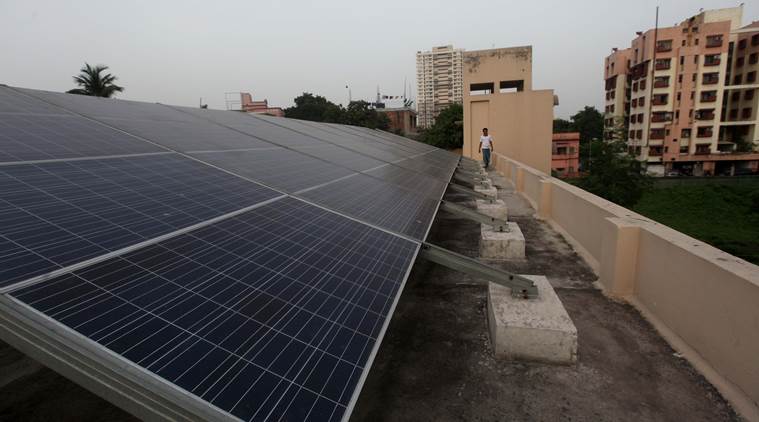An estimated 85 per cent of this equipment has been imported from three countries — primarily China, alongside Vietnam and Malaysia — with a surge coinciding with the rollout of the Centre’s ‘Make-in-India’ programme.
FIVE YEARS of a concerted solar power push, a key policy thrust area for the NDA government, has come at a cost — the value of solar photovoltaic (PV) cells and modules imported since FY’14 adds up to $12.93 billion, or Rs 90,000 crore.
An estimated 85 per cent of this equipment has been imported from three countries — primarily China, alongside Vietnam and Malaysia — with a surge coinciding with the rollout of the Centre’s ‘Make-in-India’ programme.
The amount spent on imports of PV cells and modules in the last five years works out to nearly three times the cumulative Foreign Direct Investment (FDI) of $4.83 billion that flowed into the entire renewable energy sector. It is also well over six times the budgetary allocation made by the Centre to the renewable energy sector in the five years since FY’14.
Signals policy failure
Lack of a manufacturing base for upstream stages signals a policy failure despite the massive domestic solar push. The fact that most of the imports come from China is telling.
The high import levels came despite safeguard duties being slapped by the government in the last 24 months, alongside multiple red flags being raised on the quality of solar equipment and material reaching the country.
The Secretary, Ministry of New and Renewable Energy, did not respond to a questionnaire sent by The Indian Express on the issue.
India has an installed manufacturing capacity of around 3 GW (giga watts, or 3000 mega watts) for fabricating solar PV cells and around 10 GW for modules. But it does not have any commercial production for upstream stages of solar PV manufacturing, such as wafers, ingots and polysilicon. The official reason is the energy and capital intensive nature of the process.
The lack of an integrated set-up and the economies of scale — despite the government having allowed 100 per cent FDI in the renewable energy sector through the automatic route — translates into higher cost of domestic production.
This is despite the government extending a raft of sops for the production of solar PV cells and modules. This includes support through the Modified Special Incentive Package Scheme (M-SIPS) of Ministry of Electronics & Information Technology that offers a 20-25 per cent subsidy for investments in capital expenditure for setting up a manufacturing facility.
Riding on equipment imports, the solar generation sector cornered the bulk of FDI inflows in the power sector in the last five years, also accounting for the bulk of capacity addition during this period. At the same time, thermal capacity addition recorded a progressive downward trend.
The government has a target of 175 GW of installed clean energy capacity by March 2022, of which 100 GW is expected to be solar. Over the last five years, solar power has seen its installed capacity grow around 12 times to over 31 GW, according to Central Electricity Authority data.
The problem pertaining to the quality of material used in solar projects is another fallout of the excessive import dependency by project developers.
A senior government official acknowledged a trend wherein developers taking up solar projects import used sub-standard equipment to set it up, with the result that capacity starts to report a decline in output after about a year.
Most of these developers then end up selling the project to a buyer, generally after around a year. It generally takes about three years to ascertain the actual solar efficiencies of a project.
Following a number of such cases coming to light, the Ministry of New and Renewable Energy changed rules to ensure that developers will not be allowed to dispose of a project before three years, as against a one-year stipulation earlier, officials said.
“This condition has now been put to ensure quality standard, alongside the stipulation of a minimum efficiency of 21 per cent,” an official said.
There have been some trade interventions to stymie equipment imports, but they have largely been ineffectual and had resulted in protests from developers.
Based on the findings of Directorate General of Trade Remedies (DGTR), following investigations concerning safeguard duty on imports of solar cells and modules, the government had slapped duties on imports of solar cells (on assembled modules or panels) of between 15 per cent and 25 per cent since July 2018.
Industry players, however, maintain that the duties have failed to stem the tide, with the Indian Solar Manufacturers Association contending that Chinese manufacturers have, in turn, reduced their prices.
For all the latest Business News, download Indian Express App
Source: Read Full Article





